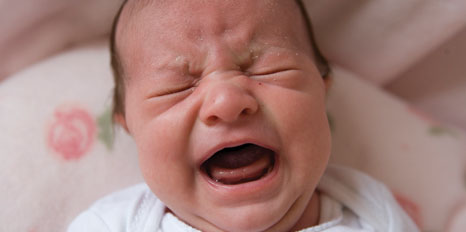
You open the door and are confronted by two tired and grumpy parents with their wailing bundle. The baby is 4 weeks old, full term and has been healthy so far, according to their pediatrician. He’s been feeding well and gaining weight steadily. There were no particular problems with the pregnancy, labor or delivery. This is the parents’ first child.
Could this be colic? Maybe. Before you proceed to the physical examination, there is an important question to ask. It’s about onset – did this crying start abruptly tonight or has the baby done this before?

All babies cry. The amount of crying increases from birth to about 3 hours daily when the child is 6-8 weeks of age, then tapers off fairly soon after that. Young babies tend to cry more later in the day, in late afternoon or evening. Some babies will draw up their legs, scream and pass gas with the episodes, appearing to be in pain. Wessel’s criteria for the diagnosis of colic includes age less than 3 months, crying more than 3 hours daily for more than 3 weeks. But many parents, especially if they think the infant is hurting or is particularly hard to soothe, will be in the ED before the 3-week mark. How do you decide who has colic and who doesn’t?
First things first: a good physical exam. Are the vitals normal? Get the infant completely undressed. Do the heart and lung exam first if the infant has stopped crying, as once they cry again all subtle findings will be lost. Is the infant hyperpneic (metabolic acidosis)? Is the heart rate too rapid (SVT)? Any signs of congestive heart failure? OK, now you can proceed head to toe. Is the fontanelle soft and flat (meningitis, intracranial injury)? Check the eyes with fluorescein to look for corneal abrasion. Evert the lids to look for an eyelash, or other foreign body. Check the belly – is it soft? Do a rectal inspection and exam, looking for fissure or intussusception (uncommon in an infant this young). Look at the genitalia for torsion or hernia. Make sure there isn’t a hair or string wrapped around the penis or clitoris. Don’t forget to check the digits for this as well. Look at the skin for bruises or burns. Palpate the extremities to check for fractures.
Ok, the exam is stone cold normal. Do I need to do any work-up? It depends. If this infant has a normal and reassuring examination and has been doing the crying thing for 3 weeks or more, all the while feeding and growing, I think you’re entitled to call this colic and move into counseling mode. If the onset has been more abrupt, but the baby still has a reassuring exam, has been feeding normally and growing, it’s probably prudent to check a urine, at least for occult infection, if not for a drug screen as well. If this is all negative and the baby still looks good, it’s not unreasonable to conclude the infant has colic. On to the counseling.
So what counseling do you give parents of colicky babies? The most important thing to tell them is that all babies cry, albeit some more than others, and that the excessive crying will most likely resolve by 3 months of age. As long as the baby is gaining weight and growing there’s no reason to be alarmed, just have the pediatrician follow the infant regularly. What to do when the baby cries? Research has shown that responding quickly can somewhat reduce the crying. It is not possible to “spoil” a baby this young. Steady rhythmic motion such as rocking or car rides help. So does white noise, like a fan or a washing machine. There is no medication that has reliably been shown to relieve symptoms. Elimination diets to reduce exposures through breast milk rarely help and should not be initiated in the ED. If the parent is at their wit’s end and having thoughts about harming the baby, they should seek help. It is OK for an extremely frustrated parent to lie the crying baby down in a safe place, close the door and step away from the situation for a few minutes to regain their composure.
Infant crying is a common problem. The two key decision points are: is this a new problem, and is the physical examination normal. Most of your job is likely to be reassurance. Plus, the car ride home might help.








1 Comment
This often is hard to swallow for these young miracles that they have actually arrived in our world. There is much more to fight, much more to see and a more spacious place to spend the rest of their lives…..maybe this is what keeps them to cry in the beginning so much !